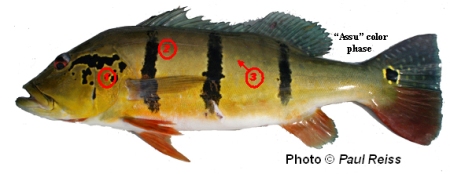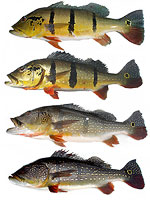Our “Fish of the Week” is Peacock Bass – Cichla temensis, which is the largest member of the peacock bass genus. This top level predator is considered by many to be the most powerful freshwater gamefish in the world, as evidenced by its current IGFA record of 27 pounds.
Cichla temensis, in its bright spawning color phase, is called “assu” in Brazil or “three-bar” in English. They become heavier and deeper bodied in this form due to prespawn changes and matured gonads. In the “paca” form, Cichla temensis displays a darker color pattern and a more hydrodynamic shape.
Cichla temensis identification is made somewhat complex by the species’ morphological variability. Specimens are encountered in two very distinct color and pattern phases, with an array of intermediate stages corresponding to their degree of reproductive readiness. The spawning pattern transformation process is gradual – the bars darken, colors brighten and the white speckles disappear. The brilliantly colored acu (pronounced ‘assu’) is in reproductively active condition. The Paca morph has white or yellow dots (3) arranged in four distinct longitudinal rows. Both morphs have 3 distinct dark bars (2) along the sides of the body and a distinct black stripe or speckled markings from the eye to the end of the opercular bone (cheek or gill cover) (1), no ocelli on the sides or at the base of the second dorsal.
Temensis is the most elongate of the Cichla species, with a body depth generally around 25 percent of its standard length (length measured to the base of the tail). It has the smallest relative scale size of the genus, generally having from 100 to 125 scales along its lateral line.
The species has three distinct, entire bars from dorsal peak to below lateral line, almost to the abdomen. It also has a distinctive postorbital band (or series of connected blotches on operculum [cheek]). In paca form, they sport four horizontal rows of light colored speckles. Its colors are extremely variable. Juveniles can grow up to about 300 cm (12 inches), while adults can grow from 300 mm up to about one meter (39 inches). Its depth to length ratio is approximately 25 percent and it has about 110 lateral line scales. Similar species include Cichla pinima and Cichla vazzoleri.
Cichla temensis’ violent behavior and awesome tackle-busting power is the primary attraction that brings avid sport fishermen to the Amazon. Its known range include the countries of Venezuela, Columbia and Brazil. Within these countries, you’ll find Cichla temensis in the Rio Negro, Orinoco, Madeira and Branco basins, with some limited populations noted in several rivers draining into the Solimoes and Amazon. Temensis primarily occupies lentic (slow or still water) environments in lagoons, backwaters and shoreline pockets. However, they will readily enter faster waters to feed and when water levels leave most lentic habitat dry. They are mostly restricted to blackwater systems. Common names for this peacock include three-barred peacock, speckled peacock, tucunare, acu, paca and giant peacock.
A primarily piscivorous (fish-eating) predator, C. temensis will behave as both a pursuit feeder and an opportunistic feeder. Their determined and aggressive fry-guarding behavior makes large acu readily accessible to sharp-eyed anglers. Cichla temensis is the premier peacock bass species pursued by trophy anglers. Its sheer size, violent attacks and general overall aggressiveness have made it the most highly regarded of all freshwater sportfish. It has spurred volumes of literature and endless variations of tactics and techniques. See our ‘Peacock Bass Primer‘ for a thorough introductory guide to catching this species in its native, pulsative river environments.
Acute Angling – Official Website
Facebook
Twitter
LinkedIn
YouTube
Photos





